What is MAEKAKE ?
Maekake are a traditional style of Japanese apron, tied at the hips and worn by craftsmen and the staff of certain shops. Maekake have been favored by workmen since the 15th century Muromachi period. The name maekake comes from mae, meaning front, and the verb kakeru, to hang.
Occasionally, the variant maetare is used, with tare derived from the verb tarasu, to drape or suspend. An essential part of the Japanese workman's uniform, maekake are worn especially among merchants and craftsmen running family businesses, and by workers in independent shops like rice, lumber and liquor stores. The simple design, a thickly woven square of cotton cloth with long straps, displays both the taste and practical wisdom of the garment's original creators.
The maekake is worn by tying the sturdy cloth around the hips and allowing the front square to drape to the ankles. The classic indigo color reflects the Japanese sense of this color as tranquil and assuring. The company or shop's trademark and name are printed prominently on the front, often along with the telephone number or year the company was founded. The apron thus functions both as an advertisement and a symbol of the wearer's pride in his or her work. Over the past several decades, the market has seen a flood of non-Japanese aprons made in China and elsewhere, but even today traditional Japanese maekake are highly valued as part of the working uniform of shopkeepers and craftsmen throughout the country.
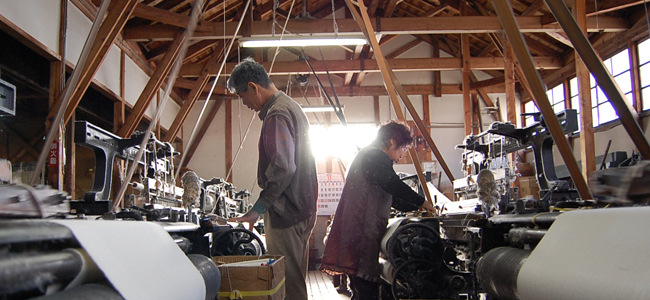
History
The History of a Classic Japanese Garment
The maekake's origins lie in the 15th century, when Muromachi-era fishermen would cut aprons from old sailcloth to tie around waists. The garment's full and formal name is ho-maekake, or sailcloth apron. In Japan, as elsewhere, necessity led to the reuse and refashioning of worn-out materials. The maekake's popularity peaked in the 1950′s and 1960′s. Most maekake were made in Toyohashi city in Aichi prefecture, some 300 kilometers (185 miles) from Tokyo. During the dramatic expansion of Japan's post-war economy, maekake production boomed, and aprons printed with a shop or company name spread among sake breweries, stores selling rice, miso, soy sauce and fertilizers, and food manufacturers across the country.
How to tie MAEKAKE
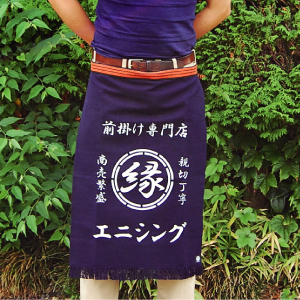
Rest the apron on the prominent bone at top of your pelvis. Postpartum mothers should instead set it on the pelvis to make the hip joint stable.
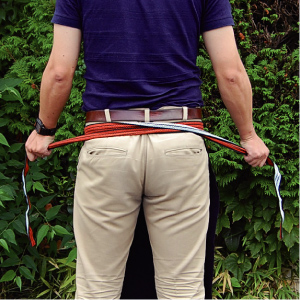
Breathe in deeply, then, release your breath lightly. Pull on the belts crossing your back tightly, then, bring them around to the front.
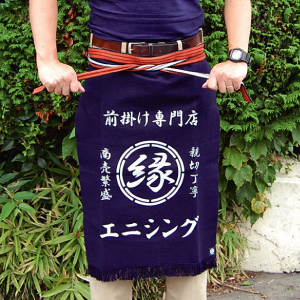
Lace up the belts securely at the front.
Exibition
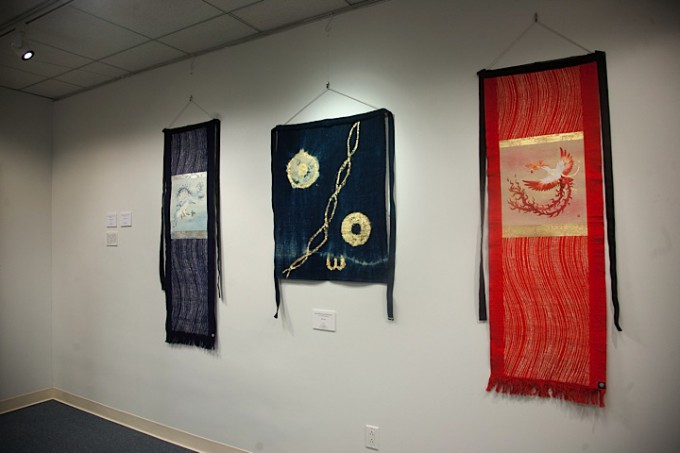
New York Exhibition 2009-2013
World Restaurants
Maekake is getting popular as a Uniforms in World Reataurants.
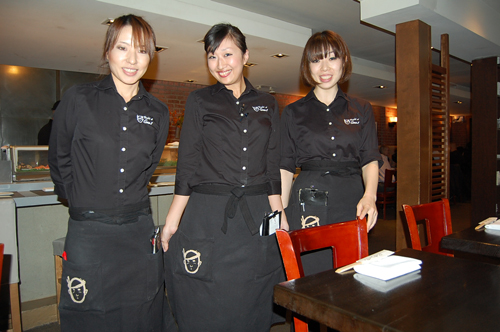
Sushi of Gari, New York
Manufactures
The Manufacture of Maekake
The main steps in producing maekake are:
1.Weaving the distinctive cotton cloth.
2.Dyeing the cloth and adding any additional designs.
3.Sewing the apron.
1. Weaving
The cloth used in maekake is made by weaving cotton threads vertically and horizontally. Typically, the width is 18.5 inches (47 centimeters), with a length of 27.5 inches (70 centimeters). Some of the weaving machines still in use are sixty to seventy years old.
2. Dyeing
Designs are created by resist dyeing the cloth, applying glue where the design is desired.
After the cloth has been dyed, the glue is removed, revealing the white-on-indigo design.
3. Sewing
Following dyeing, straps and pockets are sewn to the cloth to complete the maekake.
Straps are made with red, white and black cotton, allowing the apron to be fashioned securely about the waist. Red and white are considered lucky colors.
Company
Anything Main Office
Reservation required
Address :Room No 902, 1-7-10 MotoAkasaka, Minato-ku, Tokyo, 107-0051, Japan
Tel : +81 3 5843 0247
Mail : web@anything.ne.jp












